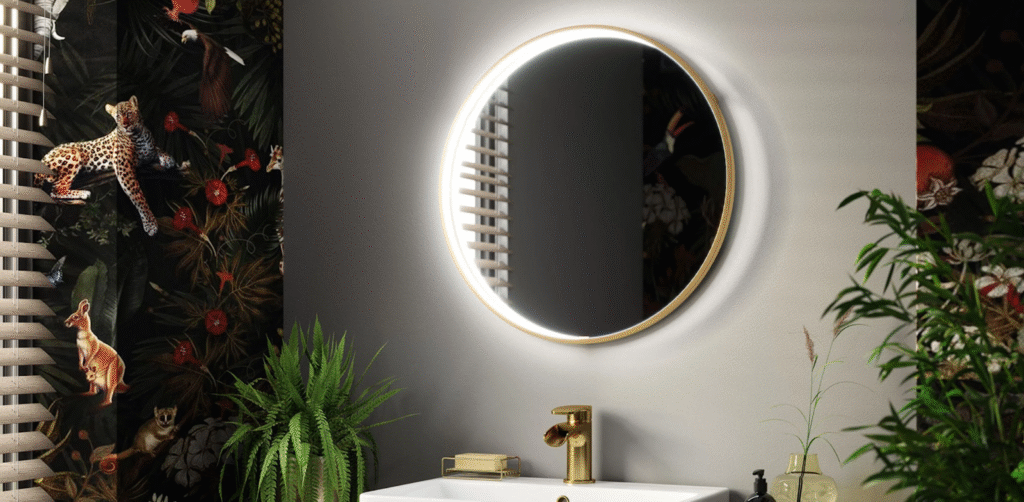
When designing or upgrading a bathroom, the vanity area is usually the center of attention. The space gains stylistic balance and practicality, and is aesthetically pleasing when a mirror is placed above the vanity, provided it is well selected. While a variety of shapes exists, round mirrors are quickly gaining traction in modern bathrooms because of their soft curves and timeless appeal. However, numerous homeowners struggle with one crucial problem: what mirror size should accompany their vanity? Ensuring the mirror matches the vanity aids in effective and pleasing functionality.
Why Size Matters in a Vanity Mirror
Your bathroom mirror, for better or worse, directly affects the ease with which you move and work in the space. A mirror that is too small will not provide a reflection, and a mirror that is too large will overpower the vanity and imbalance the space. Striking a balance creates harmony between the mirror, vanity, pendant or wall lights, and the wall. The size of the mirror impacts its effectiveness in performing basic daily activities like grooming, makeup application, or shaving.
General Rule of Thumb for Mirror Sizing
In design practice, a common rule followed by many interior designers dictates that a mirror should be a little bit narrower than the vanity. Leaving a space of roughly two to four inches would offer satisfactory alignment. So, for instance, a vanity that is 36 inches wide would be ideal with a mirror that has a diameter of 28 to 32 inches. Such a proportion not only allows for the mirror to be big enough for practical use, but also ensures it does not extend awkwardly beyond the vanity edges.
Considering the Height of the Mirror
While the width is a critical aspect of a mirror, it is equally important for the height to be considered. A round mirror should provide enough height to offer viewable space for a variety of users. Its ideal placement is at eye level of the average person in the household. Generally, the center of the mirror is positioned to be around 60 inches off the floor, but may need to be adjusted based on vanity height, the space, or the ceiling. In contrast, tall mirrors add drama and elongation to the room, while shorter mirrors tend to suit smaller bathrooms and powder rooms.
Round Mirrors for Single vs. Double Vanities
For a single vanity, one round mirror is typically sufficient as it serves as the centerpiece of the space. In the case of double vanities, there are two primary options:
1. Two individual round mirrors, one for each sink, ensuring symmetry and a balanced look.
2. One large round mirror spanning both sinks, providing a bold modern statement.
Your design choices, as well as the vanity’s dimensions, will impact your decision. In classic or transitional bathrooms, two smaller mirrors tend to dominate, while a single large round mirror is favored in sleek, contemporary spaces.
Proportions with Lighting Fixtures
Lighting is crucial when it comes to mirror choices. For example, wall sconces to the sides of the mirror may dictate its scale. Those who intend to use sconces should take care to leave wall space outside the mirror to avoid congestion. If, however, sconces are not your style, and you prefer overhead fixtures, a larger round mirror can be placed where more wall space is taken up. A sufficient balance of lighting and mirror dimensions guarantees style and functionality.
Ceiling Height and Wall Space Considerations
As is evident, not every bathroom has the same ceiling height or wall space, which impacts the positioning of the mirror. In the case of higher ceiling spaces, larger round mirrors would certainly help add some vertical balance while drawing the eye upwards. In smaller bathrooms, stout round mirrors help balance the space. When the vanity is positioned against a wall or a corner side, a smaller diameter mirror would better suit the setup, as larger mirrors would make the space feel overly crowded and claustrophobic.
The Role of Frame Style in Perceived Size
The mirror’s frame significantly impacts its perceived size. As an example, a slender, minimalistic frame lends a clean and wider appearance to the mirror, while a thick, decorative frame would make the mirror seem squished. In modern bathrooms, a frameless mirror or thin metallic-framed mirrors complement the vanity beautifully, while ornate frames add character and charm to traditional interiors.
Conclusion
Finding the right size round mirror for your bathroom vanity involves a consideration of function, practicality, and decor. The mirror should enhance the width of the vanity, fit the wall space in a well-balanced manner, and be aligned with the lighting scheme. Whether your preference is for a solo statement mirror or a pair for a double vanity, having the right proportions allows the bathroom to be cohesive, functional, and aesthetically pleasing. A round mirror, with careful consideration to width, height, and design balance, enhances the visual appeal of the bathroom.